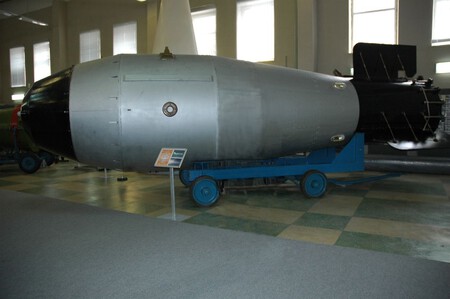On October 30, 1961, a Soviet bomber furrowed the skies of the Arctic towards Novaya Zemlya. Under his fuselage he hung an artifact the size of a bus: an unprecedented nuclear pump. At 11:32, the so -called TSAR bomb was released. A parachute slowed its fall, allowing the plane to move away. Then, a detonation illuminated the sky with a fireball of almost 10 kilometers in diameter and a fungus -shaped cloud that amounted to more than 65 kilometers. The show was surreal: the bomb, with 50 megatons of explosive power (more than 3,300 times that of Hiroshima), became a symbol of nuclear madness.
But it could be much worse.
The awakening of a new era. With the atomic bombardment of Hiroshima and Nagasaki in August 1945, the world changed irreversibly. Those bombs, 16 and 21 kilotons respectively, marked the beginning of the unparalleled destructive power of nuclear weapons. However, despite their fearsome capacity, these weapons were only the first step towards a much more sinister technological escalation.
What would later transcend the most reckless imagination. The most powerful bomb would be detonated would be that 50 megatones Soviet tsar, although designed to reach 100. However, the most disturbing thing is that this was not the summit. In hidden, the United States had planned something even more huge.
The “Super” concept. Hiroshima and Nagasaki bombs were based on fission: a chain reaction in which heavy nuclei are divided by releasing energy. But as we said, in parallel to their development, some scientists imagined a second stage: the merger.
This involved the union of light nuclei (such as deuterium and tritium) to form a heavier, releasing even more energy. It happens that this reaction required an initial fission explosion to activate, which would result in the concept of hydrogen pumps. In the 1940s they were just a theoretical speculation … but everything changed very soon.


Photograph of a replica of the tarum pump housing
Communism comes. After the detonation of the first Soviet atomic bomb in 1949, the United States accelerated its thermonuclear programs. The fear of communism, enhanced by the revolution in China that same year, made the National Security Council recommend quadruply military spending.
In that context, the figures of Edward Teller and Stanislaw Ulam appear, who devised the design that still supports the H Pumps H. In 1952, the “Mike” test of Operation IVY first demonstrated the thermonuclear principle: an explosion of 10.4 megatons (500 times Nagasaki) that left a crater of 1,900 meters wide.
Despite such force, that was not enough for Teller.
The Soundy germ. Two years later, in 1954, the so -called “Shrimp” bomb during the Castle Bravo test was triggered. A powerful explosion was expected, but the result of 15 megatons (1,000 times Hiroshima) even surprised its designers, both by strength and by the devastating level of radiation released. However, Teller’s impetus did not stop there either. I wanted more, much more.
It was then that one of the most delusional and terrifying projects of nuclear history emerged: the Soundal project. Designed by Teller and his colleagues from the Livermore Radiation Laboratory, the Plan proposed a new destruction scale: no already kilotons or megatones, we enter the gigatons.
A couple of brothers. Two weapons were designed: Gnomon and Sindial. Gnomon would act as “primary”, with a detonation of 1,000 megatons aimed at detonating Soundy, which would reach a power of 10,000 megatons, that is, 10 gigatons. For placing it in perspective, he thinks about the image of the beginning.
Well, the figure exceeds 200 times the tsar bomb, and almost does not fit in the conceptual framework of the physics of conventional explosions.
The potential apocalypse. The logic behind Sindial overflows any traditional calculation. To such powers, the laws of escalation of destruction lose any validity: heat, pressure and energy released would be so monstrous that, a priori, they would open a hole in the atmosphere.
In fact, a report of the Bulletin of the Atomic Scientists indicated that a pump like a Sindial, detonated about 45 kilometers of altitude, could cause fires in an area of the size of France. The death toll would be unthinkable, not only because of the immediate explosion but by global radioactive sequels. Hiroshima, with 140,000 victims, would be a sigh against cataclysm that would represent Sindial.

It was not science fiction. Although it might seem like a laboratory fantasy, the Soundal project was not a joke or an eccentric occurrence. Declassified documents and historical analysis indicate that the Livermore team worked seriously for years in the development of Gnomon, with concrete plans to test it in the 1956 Operation Redwing.
That test was canceled, but the mere existence of the plan shows to what extent the fear, scientific ambition and deterrence had pushed the superpowers to border the abyss of the unacceptable.
Echoes of Sindial. Suindial never materialized, but his mere conception forced a critical reflection in American politics. The growing destructive power of these weapons overflowed not only military strategy, but also ethics, logistics and land physics itself.
While many ruled out their tactical utility for being impracticable (a pump of such dimensions was impossible to launch), its potential as an instrument of symbolic terror was enormous. As with the TSAR bomb, its value was more political than operational: a floating threat that showed how far a nation could go if he wanted it.
Monster in the shadows. Finally, the Sindial project was diluted between political restrictions, international treaties and practical sense (without being preceded). The ratification of the Partial Prohibition Treaty of Nuclear Tests in 1963 was a brake on atmospheric tests, which in practice made it impossible to continue advancing in the development of extreme performance weapons.
The strategy then went on to favor smaller, portable and operational multiple eyelets, leaving behind the vision of total apocalypse that represented Sindial and its cousin Soviet sister.

Imagine the unimaginable. No doubt, today Sindial is just a footer in the history of nuclear war, but his lesson should be indelible. It reminds us of something that we should not forget now that everything seems so belligerent: there is no technical limit to the destructive power that the human being can build if he wants.
Sundial and every year of research around them were kept in a box Strong so that nobody reopens it. However, the issue does not seem so much if we can relive it, but why the hell we would like. While modern nuclear powers explore new forms of delivery (from submarine drones to hypersonic systems), the logic that gave rise to Sundial remains more latent than ever.
If you want, the threat is no longer only physical, but symbolic: that of a humanity capable of imagining its own annihilation at planetary scale.
Imagen | National Security Archive, Croquant
In WorldOfSoftware | This was the explosion of the Russian Tsar bomb that had 3,000 times the power of which it was launched in Hiroshima
In WorldOfSoftware | In 1977 a teacher asked his students a project. The FBI stayed with the best: how to build an atomic bomb at home










